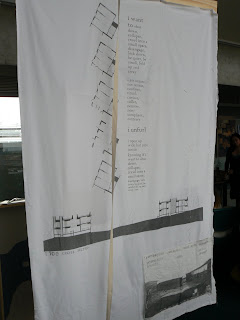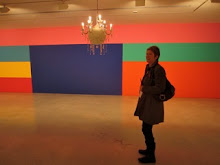"Walter Benjamin's Archive: images, texts, signs--carefully laid out manuscripts, photographs of a home with luxurious furniture, arcades, Russian toys, picture postcards from Tuscany and the Balearics, meticulous and unconventional registers, card indexes and catalog; notebooks in which every single centimetre is covered; a collation of his son's first words and sentences,; riddle and enigmatic sibyls. Everything here is subtly interconnected with everything else...the concept of 'essence' as the mark of truth." (From my notebook, day five, Tumba '10)
And what types and catalogs of lists could be used to make an archive of Reconfiguring the wall?
- A list of oft-used architectural terms (and their definitions)
- A list of processes: textile, architectural, specific to this project...
- Diagnostic terms/tests used (psychology and psychiatry)
- References used
- Types of cloth used
The list is incomplete (are all lists fated to be incomplete?)
Are they by essence (or in essence) fragments?
- detail?
- aesthetic appeal?
- intention for longevity?
- completeness in themselves?
Lists of contents have no identity of their own.
A list of images from the pieced side of the quilt:
(sources not available at this time)
- Hospital ward (beds empty)
- Rock markings from under bridge
- Patient and radiographer with x-ray machine
- Patient (?) sitting in courtyard
- Ward with window
- Map of Leichhsrt (fragment)
- John Brenan
- 4 nurses, in different uniforms
- child's drawing
- Kirkebride building
- perimeter wall....
- Kirkebride building
- perimeter wall....
A list of words/phrases from the pieced side of the quilt
- 'Sites of difference'
- 'And below is always the accumulated past which vanishes but does not vanish'
- 'Joseph was the wicked Uncle Jo who, a gambler whose debts cost the family the Balmain Estate'
- 'Eysenck Personality Inventory Personality Questionnaire'
- 'See thee shocking truth, learn the heart breaking truth about drug abuse'
- 'Recipe for plant dyeing'
- 'Ambiguous boundaries'
- 'And the resistance of space for inside out art-architecture we are able to situate the asylum in a historical context and so to [ ] the spectral quality the site evokes...'
- 'Sites of otherness'
- 'The being of art itself'
- 'Fuck it'
- 'And below is always'









